Scottish 4G Infill Programme Evaluation
This report details findings of the Scottish 4G Infill Programme (S4GI) Evaluation, informed by the best practice set out in the Digital Appraisal Manual for Scotland (DAMS): https://www.gov.scot/publications/digital-appraisal-manual-for-scotland-guidance/
6 Stage 1: Survey ‘before and after combined’ Results – Residents
6.1 Overview
6.1.1 As set out in Chapter 5, ‘before AND after combined’ surveys aimed at residents were issued by post to properties in the locations where masts had been installed. These surveys were designed to gather information on the outcomes and impacts of S4GI and the extent to which the project is achieving its Investment Objectives and included questions on the following broad topic areas:
- Broadband:
- Home broadband connectivity prior to and any changes since the delivery of S4GI
- Satisfaction with broadband
- Frequency and use of broadband
- Activities undertaken when using home broadband
- Any other comments on broadband connectivity (open text)
- Mobile connectivity:
- Mobile phone access prior to and any changes since the delivery of S4GI
- Level of mobile phone connectivity prior to and since the delivery of S4GI – inside (only where respondents does not have broadband) and outside the home
- Level of mobile phone reliability prior to and since the delivery of S4GI – inside (only where respondents does not have broadband) and outside the home
- Use of mobile services and impact of S4GI on frequency of use
- Any other comments on 4G connectivity (open text)
- Behavioural impacts of S4GI on:
- Decision to move to the area
- Nature of employment and access to learning opportunities
- Social activities, wellbeing and physical activity
- General wellbeing
6.1.2 As set out in Chapter 5, 184 survey responses were received to the resident surveys. This chapter provides a summary of these responses, working through the above topic areas, one-by-one. During the analysis of the survey, response to the open text questions were reviewed and themed. Direct quotes from the open text responses are also referred to in the below narrative where relevant.
6.2 Broadband
Home broadband connectivity
Pre-existing broadband connections
6.2.1 In total, 90% of respondents (n=165) had a broadband connection prior to the delivery of the mast and 10% (n=19) stated that they did not have a pre-existing broadband connection.
6.2.2 Amongst those with a pre-existing broadband connection (90%, n=165), 40% (n=74) said they had a decent broadband connection (defined as defined as 10 Mbit/s download and 1 Mbit/s upload speed) and 49% (n=91) said their connection was less than decent.
Key Point: A high proportion of the sample already has a usable broadband connection prior to S4GI.
Changes made to broadband connectivity
6.2.3 Of those who did not previously have a broadband connection, 32% (n=6) said they had signed up to a broadband contract as a result of the S4GI Programme compared to 53% (n=10) who had not[52].
6.2.4 Of those with a pre-existing broadband connection, 9% (n=31) stated that they had upgraded their connection because of S4GI compared to 79% (n=130) who had not and 2% (n=4) people who did not know if they had upgraded or not.
6.2.5 In total therefore, a fifth of those surveyed (20%, n=37) had made a change to their broadband connection (either upgrading or purchasing a new contract having not previously had one) because of S4GI.
Key Point: More homes now have access to broadband and existing users have upgraded their connection as a result of S4GI.
Type of broadband connection
6.2.6 Figure 6‑1 shows how all respondents’ home broadband was provided before and after the masts were delivered and Figure 6 2 shows how home broadband is currently provided to those who made a change post S4GI.
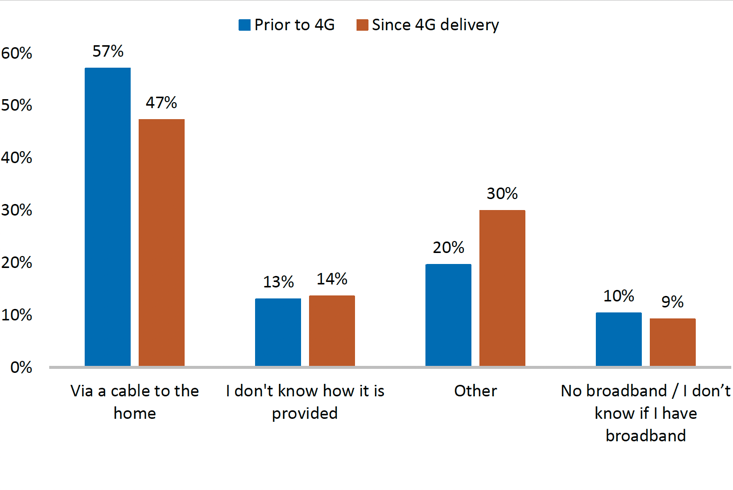

6.2.7 As shown above, there was a shift away from ‘via a cable to the home’ to ‘other’ means following the delivery of S4GI. Of the 37 people who made a change to their broadband connection, 24 (65%) selected ‘Other’, with all but 5 of these noting that they now utilised a 4G enabled connection although it is unclear as to exactly the form of this connection. Of the 5 people who didn’t reference 4G, 1 noted a fibre connection, 1 noted an aerial connection, and the remaining respondents were unsure. In the open text responses, a small number of respondents referenced being able to access fibre broadband / seeing improvements in their broadband due to being able to access the fibre connection which runs to the mast site.
Key Point: The delivery of 4G mobile technology has allowed a reasonable proportion of people in the areas affected by the programme to sign up to or improve their broadband connectivity. This is important as it means that the benefits of the S4GI Programme are not limited to mobile connectivity but also extend to those provided by home broadband.
Satisfaction with broadband connectivity
New users who had signed up to broadband having not previously had a connection
6.2.8 As discussed above, 6 respondents signed up to broadband as a result of S4GI, having previously not had a broadband connection. The sample size is therefore small but amongst this group, all respondents indicated they were satisfied with reliability and all but one indicated they were satisfied with speed, with that individual selecting ‘neither satisfied or dissatisfied’.
Key Point: New broadband users indicated they were satisfied with the service but highlighted issues with broadband provided through a mobile connection compared to fibre and superfast broadband.
Respondents who had upgraded their connection
6.2.9 In total, 31 respondents with a pre-existing broadband account upgraded their broadband due to S4GI. Figure 6‑3 shows the level of satisfaction with broadband speed and
6.2.10 Figure 6‑4 shows the level of satisfaction with broadband reliability prior to and post the delivery of S4GI amongst this group.
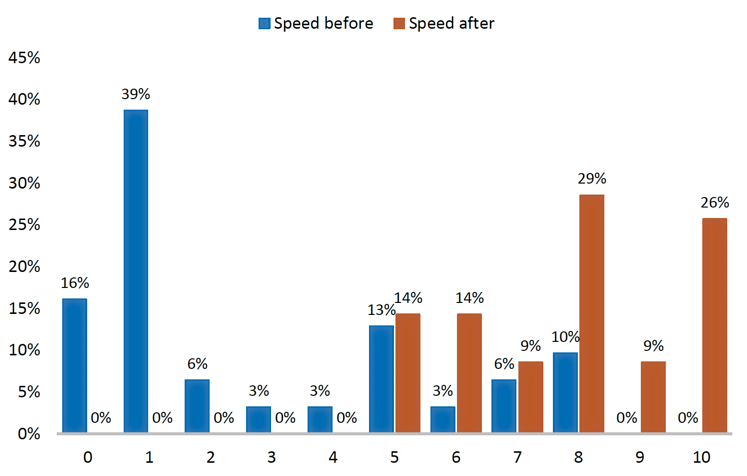
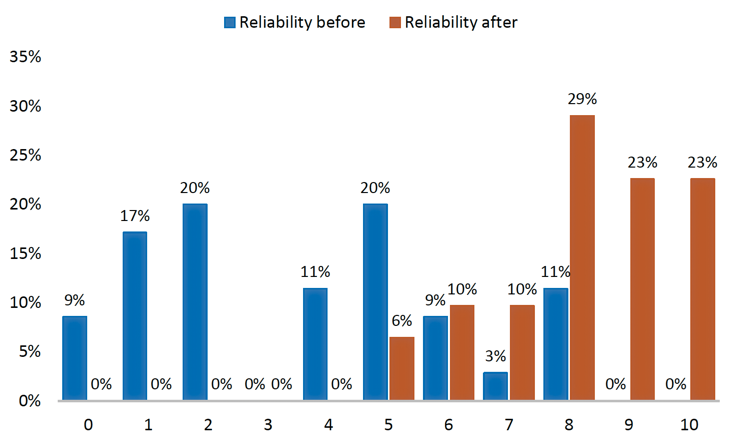
6.2.11 There is a notable improvement in satisfaction with both speed and reliability amongst those who had upgraded their broadband connection since the delivery of S4GI. On average, satisfaction with speed increased from 2.8 to 7.8 on the 0-10 scale and satisfaction with reliability increased from 3.7 to 8.1. The data therefore suggests that the availability of 4G services has led to an improvement in broadband speed and reliability amongst those who upgraded their connection.
Key Point: Those who have upgraded their broadband as a result of S4GI have seen improvements in speed and reliability.
Open text responses
6.2.12 Respondents to the survey were also asked if they had any other comments on broadband connectivity in their area.
6.2.13 The positive responses provided on speed and reliability in the survey, were echoed in some of the open-text responses to this question with a range of positive comments made, including:
- “The 4G connection has transformed our digital connection, allowing us to use online facilities routinely”
- “Since the mast was installed connectivity is excellent – a real life changer”
- “When your speed goes from 1.7 to 63, it's pretty self-explanatory”
- “The 4G connection via the…mast has seen a significant improvement in internet speed and reliability. The old telephone line connection was appallingly slow and unreliable”
- “Our broadband access is now fantastic, never had any problems”
- “The speed is good and generally reliable”
6.2.14 However, two respondents noted a desire for a fibre broadband connection, one noted that 4G connectivity is poor in some locations due to topography, and one noted broadband connectivity via a mobile does not provide the same level of service as super-fast broadband and is higher cost.
6.2.15 However, while several positive comments on broadband were received, several respondents highlighted issues. One respondent commented on being tied to one operator and reduced consumer choice / higher costs as a result:
- “I think it is a major step forward in terms of connectivity and speed, however at present the choice for the consumer is limited to EE or BT which are both significantly more expensive than other providers, this needs [to be] address[ed] to allow more choice and competition to allow users to get cheaper deals”
6.2.16 Several respondents noted issues with 4G connectivity due to topography / being unable to access the signal:
- “Although a new 4G mast was installed close by, because of the hills we don't get a huge benefit from it. We upgraded our broadband to a 4G network and have had to purchase additional mast to be able to pick up a signal from [another mast] which is 20 miles [away]… If we have bad weather, the signal can be very bad... However, it is still better than any service BT could offer. Superfast broadband is unavailable in this area, so our speed was 0.3mb it was unusable”
- “4G from [the] mast provides good signal for those who are within sight of it but because of topography some still miss out”
- “Although the 4G mast has benefitted some of the village it does not cover all of the village, hence I am reliant on a cable connection”
6.2.17 While several respondents recognised that they had seen an improvement, they also emphasised that their area remains significantly behind other areas of the country in terms of connectivity, and they would like to see cable / fibre connections:
- “Given it is a completely new install I expected better speeds. Basically, we are now at an acceptable speed whilst many other parts of the country are now moving onto full fibre with speeds in excess of 100mbs”
- “I wish we had normal cabled internet, I feel like we are well behind the times being so isolated”
- “Speeds are marginally above the required minimum. What’s happening with fibre to the premises?”
- “4G is fine but we really need fibre”
6.2.18 Related to the above, a number of respondents also noted the high cost of 4G broadband compared to cable / fibre internet options:
- “Landline connectivity is very poor, and like other rural, remote and low population areas, landline capacity has not kept up to date with the requirements of data transfers. The best speeds and capacity that I can get is via a mobile signal (which is nowhere near super-fast broadband speeds) but is still charged at about double 'superfast' costs!”
- “Only [an] improvement via 4G… Would be good to have options - 4G is more expensive”
6.2.19 One respondent noted that there is a resilience issue where broadband is provided via 4G connectivity:
- “[There is] no means of communication during a significant power cut – [the] mast disconnects after a 3-hour power outage so broadband and phone unusable as signal for both obtained via EE 4G mast”
6.2.20 Overall, amongst those who had made a change to their broadband connection due to S4GI, there was a fairly even split between positive comments and comments highlighting issues.
Key Points: the sample reports improvements in speeds and reliability. However, issues with local connectivity and the dependence on a single provider were cited as problems by some. There was also a general aspiration for further improvements to broadband services.
Frequency and use of home broadband
6.2.21 Respondents were also asked about their frequency of use of home broadband. Figure 6‑5 shows how frequently those with broadband use their broadband connection. The results are split between those who had newly signed up to broadband; broadband users who upgraded their broadband connection; and broadband users who did not upgrade their connection. As shown, the majority of people across all categories used their current home broadband several times a day, with those who upgraded displaying the highest levels of use – although it is noted that sample sizes are small for some categories.

Key Point: those who have upgrade their broadband are the heaviest broadband users in the sample.
Activities undertaken when using home broadband
Users who had upgraded their existing broadband connection
6.2.22 Respondents who had upgraded their existing broadband connection were asked if the change had led to an increase or decrease in how frequently they undertake a range of activities. Figure 6‑6 shows the response to this question amongst this group.
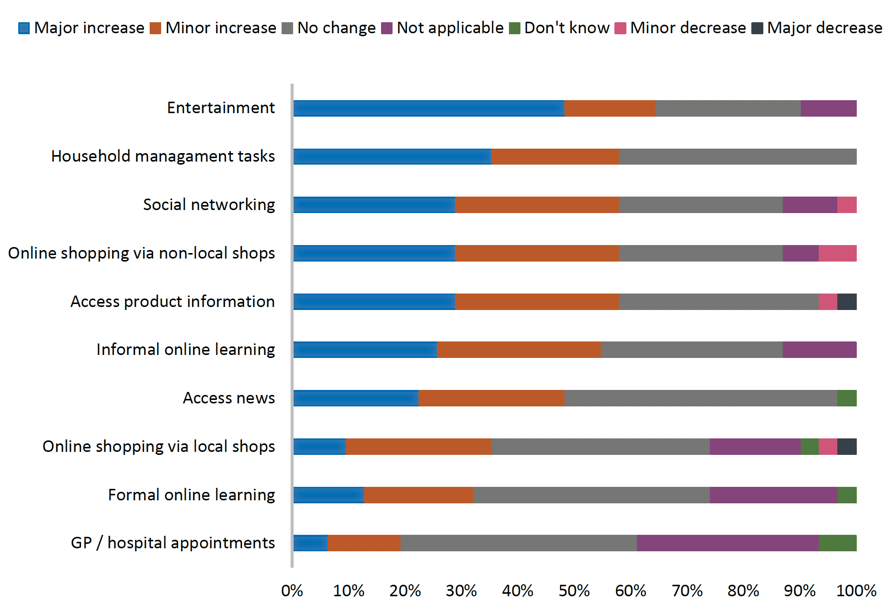
6.2.23 Those who upgraded their broadband generally increased their use of broadband across a wide range of activities. The largest increase in use was entertainment with 65% of respondents stating that upgrading their broadband had led to an increase in entertainment-based activities using their broadband connection. There were also large increases in broadband use for ‘household management tasks’, ‘accessing product information’, ‘social networking’, and ‘online shopping via non-local shops’. While a majority of people stated that there was ‘no change’ in the way they undertook GP / hospital appointments, a reasonable proportion (19%) indicated that their use of home broadband for this purpose had increased.
6.2.24 In the open text responses to the survey, one respondent who had upgraded their broadband connection noted that improved broadband connectivity had enabled them to work from home which previously they were unable to do:
- “I now work from home 3-4 days a week - having secured full time employment thanks to broadband improvement”
6.2.25 The increased use of broadband connectivity by those in the communities affected by S4GI and the resulting changes in how activities are undertaken will have important implications, both for how the communities operate (i.e., the level of locally available services versus services provided online) and how individuals within these communities feel (i.e., levels of personal wellbeing and connectedness). These aspects are explored further below.
Key Point: There is clear evidence that broadband upgrades via S4GI have brought a range of benefits to households through improved access to a range of online services.
6.3 Mobile connectivity
Mobile phone access
6.3.1 Respondents were asked whether they had a smart phone prior to S4GI. In total:
- 3% (n=5) did not own a mobile phone
- 15% (n=28) had a mobile phone but not a smartphone
- 82% (n=151) had a smartphone
6.3.2 Those who indicated that they did not have a mobile phone prior to S4GI were asked if they had purchased or taken a contract out for a mobile phone in order to take advantage of the 4G connectivity provided through the S4GI Programme. In total, 2 out of the 5 respondents had made this change, with one signing up with the operator EE (the main operator on the S4GI Programme) and the other signing up with Vodafone.
6.3.3 Those who had a mobile phone prior to S4GI but not a smartphone were asked whether they had upgraded their mobile phone and / or changed their operator (where required) in order to take advantage of the 4G connectivity provided through the S4GI Programme. As shown in Figure 6‑7, 33% of the 28 people in this category (n=9) upgraded to a smart phone and, of these, 6 also changed their operator.
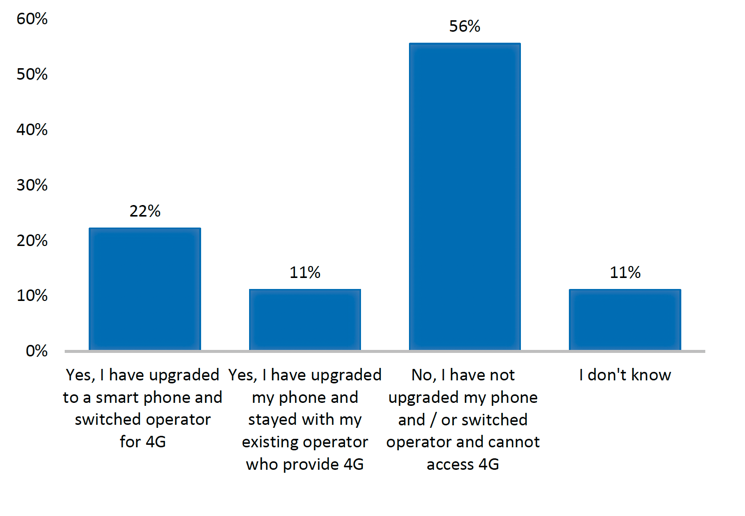
6.3.4 Those with a smartphone prior to S4GI were also asked whether they had changed their operator in order to take advantage of the 4G connectivity provided through the S4GI Programme. As shown in the figure below, 29% (n=44) changed their operator.
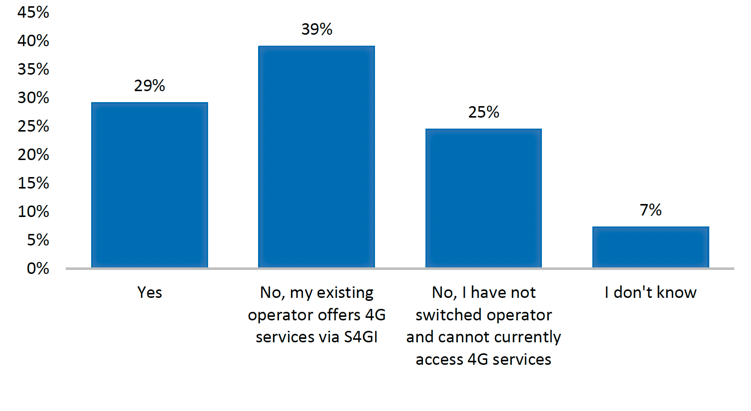
6.3.5 Figure 6‑9 shows the mobile phone operator used by respondents prior to and post the delivery of S4GI.
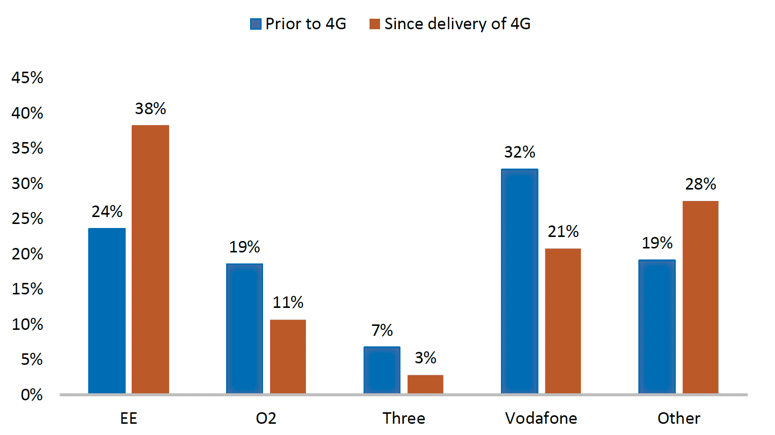
6.3.6 As shown there has been a shift towards EE (the main operator for the S4GI Programme) and ‘other’ operators since the delivery of S4GI. In total, 7 respondents who had changed provider ticked ‘other’ and all of these switched to a provider who make use of the EE network.
6.3.7 Overall, more than a quarter of respondents (29%, n=53) of respondents had made a change to their mobile status (either purchasing a phone, purchasing a smartphone, and / or changing their operator) in order to take advantage of the 4G connectivity provide through the S4GI Programme.
Key Point: S4GI has resulted in significant behavioural change with more people acquiring a smartphone and previous smartphone users switching operators to take advantage of the new 4G service.
Mobile phone connectivity and reliability
6.3.8 The respondents who indicated that they currently have a smartphone were asked a series of questions about their satisfaction with phone connectivity and reliability prior to and post the delivery of S4GI.
6.3.9 A different set of questions was used depending on whether respondents had home broadband as follows:
- Those who did not have broadband – were asked questions about the level of mobile phone connectivity and reliability inside and outside their home as they are reliant on their mobile phone for internet access in both locations.
- Those who had home broadband – were asked questions about the level of mobile phone connectivity and reliability outside their home only as it was presumed that they would use their broadband connection rather than their mobile connection when they were inside their home.
Connectivity and reliability inside the home (where respondent does not have home broadband)
6.3.10 As discussed above, 10 respondents indicated that they (i) did not have broadband prior to S4GI and (ii) had not upgraded their broadband as a result of the programme. Of these, three people indicated that they had a mobile phone but not a smartphone prior to 4G, and either did not upgrade their phone or switch operator, hence could not access 4G services.
6.3.11 Figure 6‑10 shows the level of mobile phone connectivity inside the home and Figure 6‑11 shows satisfaction with the reliability of mobile services inside the home reported by the seven remaining people. The latter is shown on a scale with a rating of ‘0’ being least reliable and ‘10’ being most reliable).
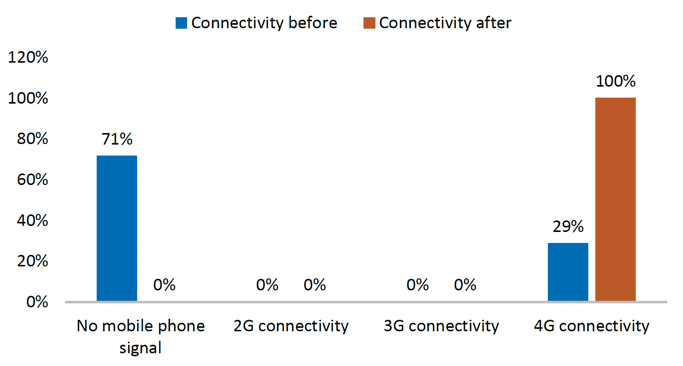
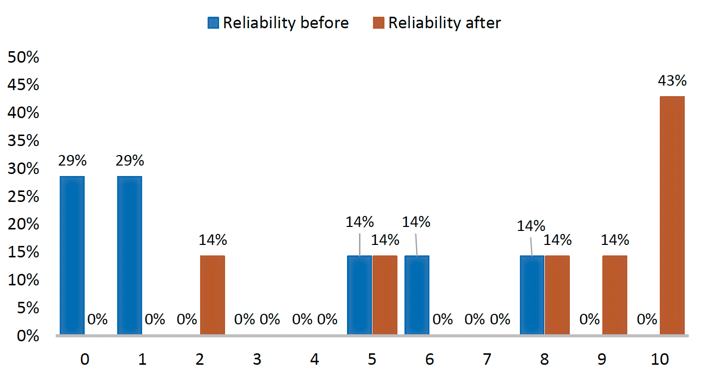
6.3.12 While the total number of respondents here is small (n=7) and therefore it is difficult to draw any firm conclusions, the data does suggest a general improvement in both mobile phone connectivity and reliability inside the home.
Key Point: those still without home broadband but with a smartphone report improved connectivity and reliability inside their homes as a result of S4GI.
Connectivity and reliability outside the home (for those with and without home broadband)
6.3.13 Figure 6‑12 shows the level of mobile phone connectivity outside the home and Figure 6‑13 shows satisfaction with the reliability of mobile services outside the home reported by those with and without home broadband. The latter is shown using the same scale with a rating of ‘0’ being least reliable and ‘10’ being most reliable.

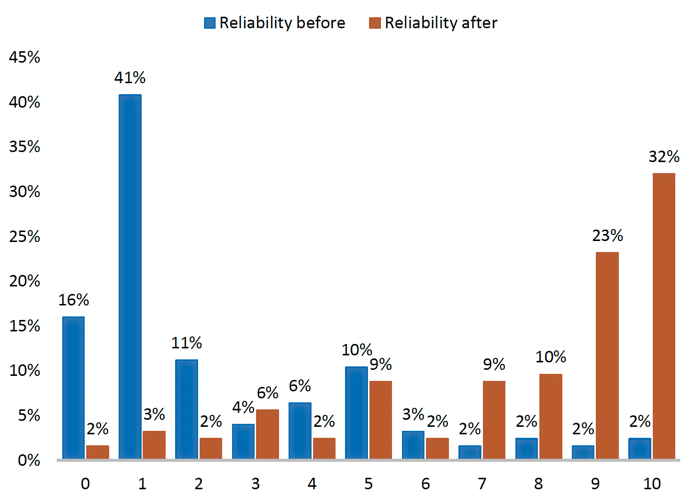
6.3.14 As shown, there were considerable improvements in mobile connectivity outside the home with 81% (n=96) stating that they had 4G connectivity following S4GI compared to just 4% (n=5) prior to the masts being installed. The majority of respondents (73%, n=89) indicated they had no phone signal prior to the delivery of S4GI and therefore a large proportion of users saw a major improvement in service.
6.3.15 There were similar gains in mobile phone reliability, with 76% (n= 95) of respondents now satisfied (scoring 6 and above) with their 4G reliability as opposed to just 11% (n=14) who felt this way prior to the delivery of S4GI. Overall, average satisfaction with mobile phone reliability outside the home increased from 2.4 to 7.6 following the delivery of the programme.
Key Point: the survey results indicate that there have been significant improvements in connectivity and reliability outside the home.
Open text responses
6.3.16 Respondents to the survey were also asked if they had any other comments on mobile connectivity in their area.
6.3.17 The positive responses provided on mobile connectivity and reliability in the survey, were echoed in some of the open-text responses to this question:
- “Mobile phone connectivity in my area is now brilliant with no dead spots where I cannot gain access to the internet or make a voice call…I have cancelled my landline as we no longer needed or used it so was a waste of money and use a smartphone for everything”
- “The Scottish 4G Infill Programme has made a huge difference to the internet connectivity in a very remote part of the highlands. Thank you!”
- “It makes me feel part of the wider world, although I live right in the country.”
6.3.18 As well as general comments like the above, respondents also made more specific comments on how they use 4G and the benefits it provides. These are discussed further in the next section.
6.3.19 However, while a large proportion of respondents noted the positive benefits, some negative aspects were also highlighted. Comments were made about mobile signal reliability and strength in some areas, with topography and / or weather conditions highlighted by some as potential causes:
- “Service is overall good but there are intermittent signal failures. Not fully dependable.”
- “We are living in a very rural location and the signal can fluctuate with weather conditions.”
- “Definitely improved vastly but still several "dead" spots.”
- “It is still very sporadic, there are lots of areas near me where it cuts out completely”
- “Those residents with direct line of sight to mast have reported an increase in accessibility to services, but for our end of the village there is an increase in speeds and reliability via the cable but certainly not outside or around the property.”
6.3.20 Several respondents raised the issue of needing to be with one / specific provider(s) in order to access services and a number noted they could not access services with their current provider:
- “It is fine for us because we have changed to BT/EE mobile, but visitors on different networks can't get a signal.”
- “I'm on EE which helps, I know other people are still a bit baffled, some didn't realise they could change to EE and get the signal.”
- “There is very poor connectivity with Vodaphone and none on either my son or daughter’s mobile phone operators. It is particularly unfortunate, as for safety reasons, with children out on bikes, there is no reception to call home in case of an accident.”
6.3.21 Some respondents also noted that the cost of joining those providers with access to the mast was higher compared to others. This is an important point given that cost is one aspect in the Digital Divide:
- “[It is] frustrating that the mast is operated by EE, and due to only Band 20 (I think) being available for public use that a contract must be used rather than Pay as you go. Essentially EE has a monopoly on the mobile phone services. I was previously using Three Mobile who are considerably cheaper”.
- “Please open it up to allow more competition through other providers and allow less expensive packages be available to local consumers, other than that well done!”
6.3.22 One respondent also referenced being ‘locked in’ to one contract. This is an important point since the benefits of S4GI for some individuals will not materialise until they finish their current broadband or mobile phone contract:
- “Unfortunate that we are locked into one provider (EE).”
6.3.23 Two respondents also noted that the mast ‘blocks’ the signal from other providers:
- “We are not able to access it without buying into EE and it has blocked all other signals, so has made our connectivity worse”.
- “The mast not only doesn’t help us, it blocks our signal and only when we are out of its signal can we use our phone”.
6.3.24 While recognising the benefits, several respondents questioned by 5G was not provided:
- “Whilst I am grateful there is now a signal, where there was none before it is a shame that given it's a completely new install that the opportunity to provide 5G was not taken”
- “The service is good, but i do wonder why a 4G network was setup and not 5G”
- “Now for 5G”
6.3.25 Overall, around 30% of the open-text responses were positive and around 50% highlighted issues, with the remainder being broadly neutral.
Key Points: the sample reports significant improvements in connectivity and reliability of the mobile phone signal outside the home. However, the dependence on a single provider and patchy local connectivity were cited as problems by some.
Use of mobile services and impact of S4GI on use
6.3.26 All respondents who can now access 4G through a new or previous operator were also asked whether the availability of 4G mobile technology had led to an increase in their use of mobile services. In total, three quarters indicated that they now utilise mobile services more often, with the majority of these stating that they use mobile connectivity both inside and outside the home (see Figure 6‑14).
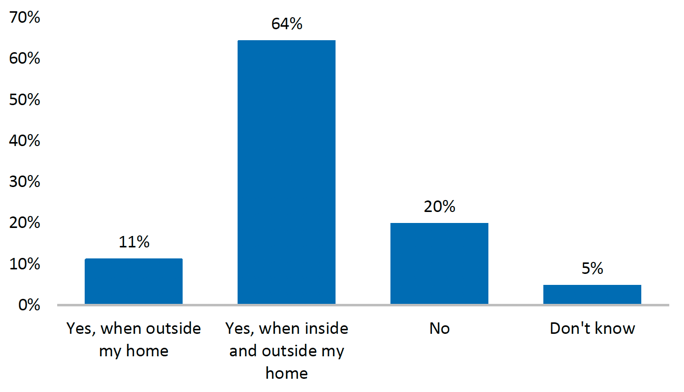
6.3.27 Respondents with a smartphone were also asked whether the availability of 4G mobile connectivity had led to an increase or decrease in how frequently they undertake a range of activities using a mobile connection. The results are shown in Figure 6‑15.
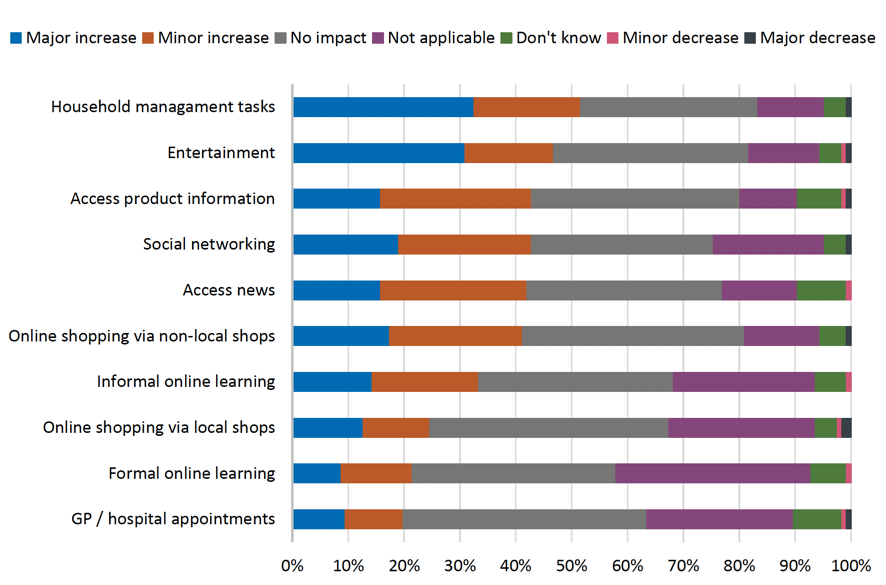
6.3.28 As shown in the figure above, the use of mobile services has increased across the majority of the activities listed. Approximately half of respondents had increased the frequency at which they use their mobile for household management tasks (52%, n=65) and entertainment (47%, n=64). Between 40% and 45% of respondents had also increased their use of mobile services for social networking, online shopping via non-local shops, accessing news and product information.
6.3.29 The use of mobile services for various activities was also identified within the open text responses.
- “4G has helped massively with banking and online shopping”
- “It has made everyday tasks easier to manage”
6.3.30 In terms of household tasks, while not specifically identified in the survey, a number of respondents noted the benefit of being able to receive security confirmation texts when using mobile banking:
- “4G has allowed us to use a wide range of sites that require two factor identification.”
- “Since new mast, have been able to fully use phone, which is becoming vital to use online banking / credit card transactions to confirm ID via texts. As retirees, getting a proper connection has enabled us to "keep up with the times" re online banking etc”
- “Previously I had no mobile coverage in the house, so it limited fully using online broadband services, as I was unable to access e.g., text verification codes unless I drove or walked a quarter mile up the hill. Because of this I couldn't always access opening new accounts for online shopping and online banking.”
- “We always had good Wi-Fi and Wi-Fi calling but now have a mobile signal at home so we can receive texts”
Key Points: respondents with 4G smartphones report increased use of mobile 4G services across a wide range of online services as a result of S4GI.
6.4 Life choices – moving to the area
Decision to move to the area
6.4.1 Respondents were asked how long they had lived at their current address. In total, 90% (n=166) of respondents had lived at their current address for more than two years and 10% (n=19) had lived at their current address for less than two years.
6.4.2 Those who had moved within the last two years were asked how important the future availability of 4G in their area was in their decision to move to their current address. The results are shown in Figure 6‑16.
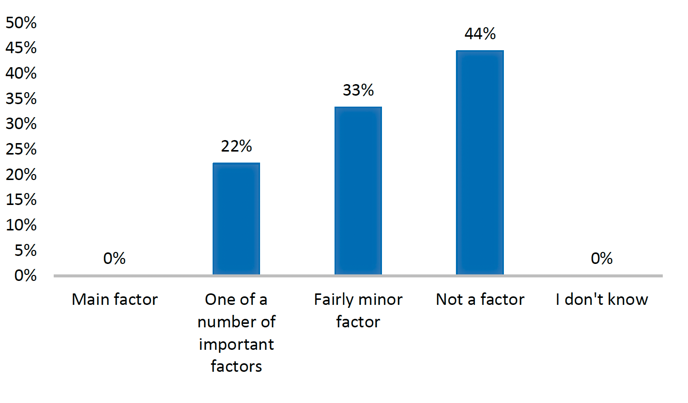
6.4.3 Although no-one considered the future availability of 4G in their decision to move a ‘main factor’, 56% (n=10) said that it was either ‘one of a number of factors’ or a ‘fairly minor factor’.
6.4.4 Those who had moved within the last two years were also asked whether they would have moved to their property had the delivery of 4G services in the area not been planned. While 83% (n=15) said that they would still have moved regardless of the S4GI Programme, 11% (n=2) stated that they were unsure if they would have, and one person said they would not have moved were it not for S4GI.
6.4.5 While the sample sizes are small and therefore it is difficult to draw firm conclusions, the survey data does provide some indication that the future availability of 4G did influence people’s decision to move property.
Key Point: there is some evidence that the S4GI Programme has removed a potential barrier for some when considering where to live.
Nature of employment and learning opportunities
Respondents were also asked whether the availability of 4G services had resulted in changes in the nature of their work and / or ability to access learning opportunities. The results of this question are shown in Figure 6‑17.

6.4.6 In total, 25% of respondents (n=9) said they were able to work from home more, and three said they were able to set up a new business, get a higher paid job or work more hours.
6.4.7 A range of positive benefits in terms of employment were also identified within the open text responses:
- “It has enabled me to work from home which is positively life changing.”
- “It has facilitated delivery drivers contacting us... meaning improved service”
- “Very happy thank you. Literally changed our lives as we work for ambulance service from home (paramedic and technician). We could not leave the house before 4G on duty because we had to have the house phone with us. Now we can be reliably reachable from anywhere on our croft. It's also made working on our croft and walking safer.”
- “It allows me to work from home; It allows me to do my job which I wouldn't have if not working from home.”
6.4.8 In addition to changes in employment, more than a quarter of those surveyed (69%, n=25) said the delivery of 4G had enabled them to access learning opportunities they previously could not access:
- “4G allows me to study online.”
Key Point: S4GI has allowed some people to make positive changes to how and where they work, removing a barrier to labour market efficiency.
Social activities, wellbeing, and physical activity
6.4.9 Respondents were also asked whether the availability of 4G had had a positive or negative impact on their ability to undertake a range of activities. Responses to this question are shown in Figure 6‑18.
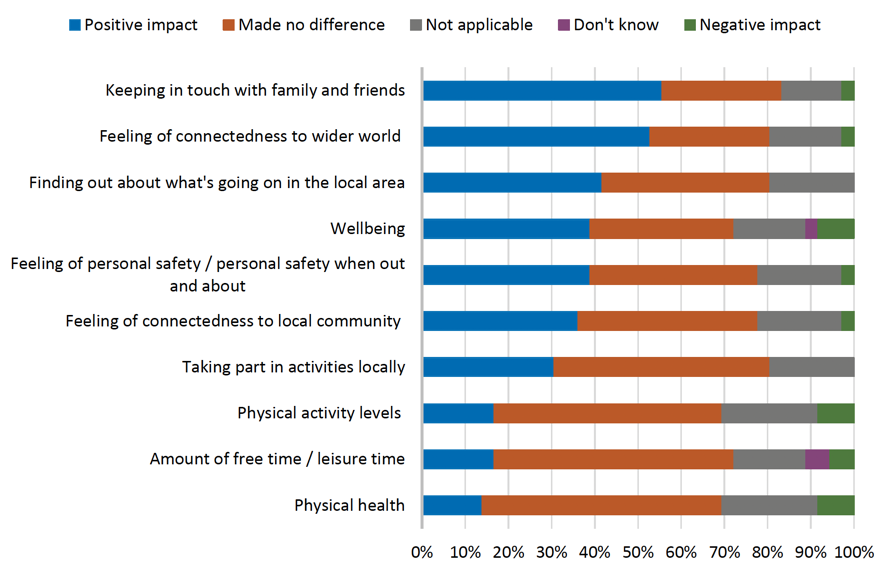
6.4.10 As shown, the delivery of 4G has had a positive impact on a range of activities, with particularly positive impacts in terms of social interaction and wellbeing. The aspects for which the largest proportion of respondents recorded positive impacts include:
- Keeping in touch with family and friends (56% recording positive benefits, n=20)
- Feeling of connectedness to the wider world (53% recording positive benefits, n=19)
- Finding out about what's going on in the local area (42% % recording positive benefits, n = 42%)
- Feelings of personal safety / personal safety when out and about (39% recording positive benefits, n=14)
- Wellbeing (39% recording positive benefits, n=14)
6.4.11 A small proportion of people also stated that S4GI had a positive impact in terms of physical activity levels and physical health. This was also the case with respect to ‘amount of free time / leisure time’.
6.4.12 While based on a small sample, the data from the survey suggests that the delivery of 4G has resulted in a wide range of benefits. Beneficial impacts of 4G availability were also identified in the open text responses to the survey.
6.4.13 Several respondents to the survey identified the safety benefit of mobile connectivity and the reassurance this provides in terms of being able to make calls when out and about within the community:
- “It's very reassuring to have. 4 years ago I came across a tractor turnover, driver badly injured but no mobile signal delayed getting respondents out”
- “Having a mobile phone signal makes me feel much safer when outside.”
- “It has increased my safety and security during regular power outages that cause my router to not work.”
6.4.14 The resilience benefit of having mobile connectivity in the event of a broadband outage was also identified:
- “It's been excellent, use it for calls a lot and good to have back up if broadband is down.”
- “We have had quite regular power cuts with storms and snow, in last few years.. 4G has kept us connected even when broadband has gone.”
- “Very useful during power cuts when we can't access broadband.”
6.4.15 There were also a range of general comments on the benefits in terms of quality of life, wellbeing, and the sustainability of local communities:
- “Superb. The connectivity has improved life and living and working immensely. Without it, it would not be sustainable to live in the area. 4G has made life so much easier, opened-up greater opportunities and provided greater peace of mind”.
- “The 4G connectivity in my area has vastly improved my lifestyle with being able to connect with people in our circle whether at home or on the go.”
- “The arrival of the S4GI has changed my life. It's great.”
- “Catching up with the rest of society has definitely improved my quality of life and enabled me to save money on telephone and broadband services.”
Key Point: S4GI has produced a range of benefits to people in terms of leisure and quality of life.
6.5 Wellbeing
6.5.1 As discussed in Section 3.6, there is much discussion in the literature on the ability of improved digital connectivity to improve levels of both individual and community wellbeing. However, capturing wellbeing benefits is particularly challenging, in part because wellbeing cannot be directly quantified or monetised as is the case with economic benefits and there are a diverse range of factors which influence wellbeing, making it difficult to isolate the impact of S4GI.
6.5.2 To help identify wellbeing impacts, the survey replicated the questions on personal well-being included within the UK’s Annual Population Survey (APS)[56]. Respondents were asked one question covering each of the four measures of personal wellbeing[57], as follows:
- Life satisfaction - Overall, how satisfied are you with your life nowadays?
- Feeling the things done in life are worthwhile - Overall, to what extent do you feel that the things you do in your life are worthwhile?
- Happiness - Overall, how happy did you feel yesterday?
- Anxiety - Overall, how anxious did you feel yesterday?
6.5.3 As with the APS, respondents were asked to rate their wellbeing on a scale between “not at all’ to “completely” where 10 is equal to the latter.
6.5.4 Personal wellbeing is reported in the APS as both average means and thresholds, with the latter defined as set out in Table 6‑1.
Life satisfaction, worthwhile, happiness |
Ratings |
Anxiety |
Ratings |
|---|---|---|---|
Low |
0 to 4 |
Very Low |
0 to 1 |
Medium |
5 to 6 |
Low |
2 to 3 |
High |
7 to 8 |
Medium |
4 to 5 |
Very High |
9 to 10 |
High |
6 to 10 |
6.5.5 Figure 6‑19 summarises the overall results to the four wellbeing questions as defined above. Note that not all respondents answered all four questions.
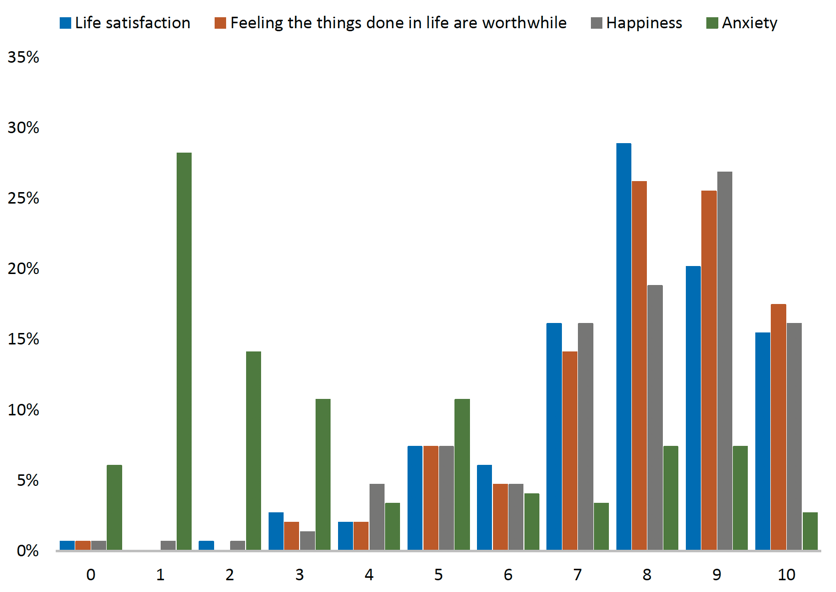
6.5.6 The ‘before AND after combined’ surveys only asked about current wellbeing; there were no questions on levels of wellbeing prior to the delivery of the masts. To help identify any change in wellbeing, Table 6 2 compares the average mean wellbeing scores established via the ‘before AND after combined’ surveys with those collated via the ‘before’ surveys. The total sample size for the latter was 43[59]. As well as the mean scores in each case, corresponding APS thresholds as defined above is also shown in brackets.
Wellbeing |
Areas which were scheduled for S4GI investment (‘before’) |
Areas where masts had already been installed (‘before AND after combined’) |
Change |
|---|---|---|---|
Overall, how satisfied are you with your life nowadays? |
7.8 (High) |
7.7(High) |
-0.1 |
Overall, to what extent do you feel that the things you do in your life are worthwhile? |
8.0 (High) |
7.9(High) |
-0.1 |
Overall, how happy did you feel yesterday? |
7.6 (High) |
7.7(High) |
0.2[60] |
On a scale where 0 is “not at all anxious” and 10 is “completely anxious”, overall, how anxious did you feel yesterday? |
3.1 (Medium) |
3.6 (Medium) |
0.5 |
Key Point: Overall, wellbeing is relatively high in the areas surveyed. While there are some changes between the ‘before’ and ‘before AND after combined’ surveys, these differences are marginal, and it is difficult to attribute any changes directly to the S4GI Programme.
Contact
Email: sean.murchie@gov.scot
There is a problem
Thanks for your feedback